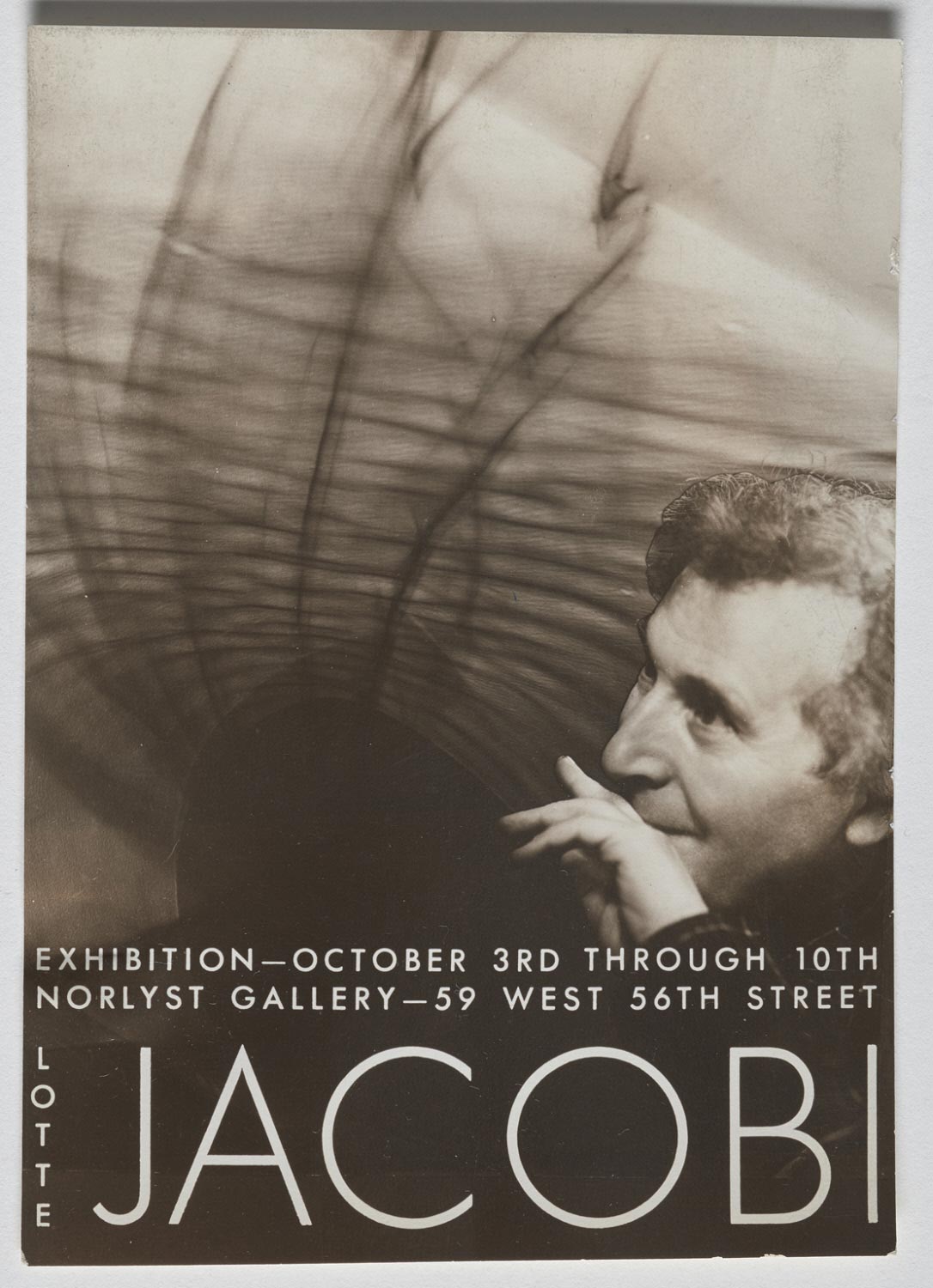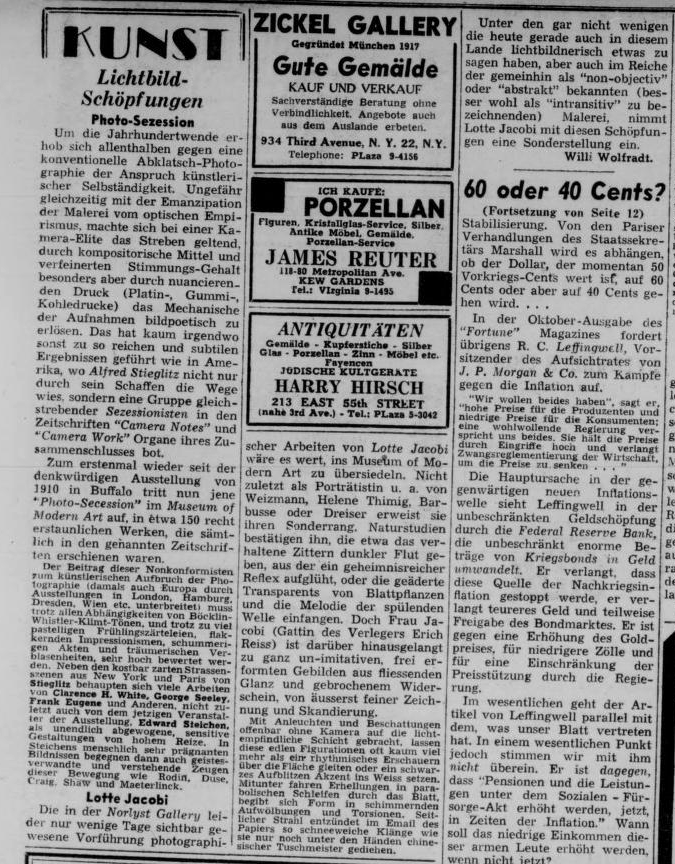Archive
https://archive.metromod.net/viewer.p/69/2948/object/5145-11005406
Archive
Norlyst Gallery
- Norlyst Gallery
- GalleryArt Gallery
Founded in 1943 by the American painter and art collector Elenore Lust, the Norlyst Gallery represented a cross section of contemporary painting, photography and other media focusing on surrealist and abstract expressionist styles and promoting women artists and photographers.
Word Count: 38
59 West 56th Street, Central Park South, Manhattan, New York City.

Flyer for the Captured Light exhibition (© The Josef and Yaye Breitenbach Charitable Foundation, courtesy of The Center for Creative Photography, Josef Breitenbach Archive, AG90:29). 
Announcement for the Captured Light exhibition (© The Josef and Yaye Breitenbach Charitable Foundation, courtesy The Center for Creative Photography, Josef Breitenbach Archive, AG90:29). 
Flyer for Lotte Jacobi’s exhibition at the Norlyst Gallery, 1948 (© 2020. University of New Hampshire). 
Willi Wolfradt. "Lichtbild-Schöpfungen." Aufbau, 15 October 1948, p. 19. Downes, Bruce. “Exhibition of the Month. Captured Light: Experimental Photography.” Popular Photography, September 1944, pp. 32f., 95ff.
In Wonderland: The Surrealist Adventures of Women Artists in Mexico and the United States, edited by Ilene Susan Fort and Teresa Arcq, exh. cat Los Angeles County Museum of Art, Los Angeles, 2012.
Kraus, Felix. “Why Photographers experiment.” Popular Photography, February 1945, pp. 27–29.
Kuspit, Donald. Jimmy Ernst. Hudson Hill Press, 2000.
Sawin, Martica. Surrealism in Exile and the Beginning of the New York School. MIT Press, 1995.
Wolfradt, Willi. "Lichtbild-Schöpfungen. Photo Sezession." Aufbau, 15 October 1948, p. 19
Word Count: 126
My deepest thanks go the Josef Breitenbach Estate and the Center for Creative Photography, The University of Arizona, Tucson.
Word Count: 19
- 03-1943
- 05-1949
Josef Breitenbach, Andreas Feininger, Rolf Tietgens, Ruth Bernhard, Lotte Jacobi, Marion Palfi.
- New York
- Helene Roth. "Norlyst Gallery." METROMOD Archive, 2021, https://archive.metromod.net/viewer.p/69/2948/object/5145-11005406, last modified: 04-05-2021.
-
Josef BreitenbachPhotographerNew York
On arriving in New York in 1941, the German photographer Josef Breitenbach tried to restart as a portrait, street and experimental photographer, as well as a teacher of photo-history and techniques.
Word Count: 30
Rolf TietgensPhotographerEditorWriterNew YorkRolf Tietgens was a German émigré photographer who arrived in New York in 1938. Although, in the course of his photographic career, his artistic and surrealist images were published and shown at exhibitions, his work, today, is very little known.
Word Count: 39
Marion PalfiPhotographerNew YorkMarion Palfi was a German émigré photographer who lived in New York from the 1940s to the 1960s. Her photographic engagement in social and political topics made her name for her use of the camera to draw attention to social injustices.
Word Count: 41
Lotte JacobiPhotographerNew YorkIn October 1935 the German émigré photographer Lotte Jacobi, together with her sister Ruth Jacobi, opened a photo studio on 57th Street. The two sisters had to leave their parents' photo studio in Berlin in the 1930s and emigrated to New York.
Word Count: 41
YllaPhotographerNew YorkYlla was an Austrian-born photographer who emigrated to New York in 1941. Specialising in animal photography, she produced not only studio photographs, but also shot outside on urban locations in the metropolis.
Word Count: 31
J.J. Augustin Incorporated PublisherPublishing HouseNew YorkJ.J. Augustin was a German publishing house in Glückstadt with a long history, going back to 1632. In 1936 the American branch opened in New York with a large artistic and cultural focus.
Word Count: 33
Camera FeaturesPhoto AgencyNew YorkCamera Features was a photo agency founded by the photographer Werner Wolff and other colleagues of the photo agency PIX.
Word Count: 20
Weyhe GalleryArt GalleryNew YorkOpened in 1919 by the German-born art dealer Erhard Weyhe opened a bookstore and gallery space specialised in contemporary European artists and was the first to specialise in prints.
Word Count: 28
Julien Levy GalleryArt GalleryNew YorkThe Julien Levy Gallery was founded by the art dealer Julien Levy (1906–1981) in 1931, and was situated in the New York gallery district around 57th Street, where the Weyhe and Norlyst Gallery were also located.
Word Count: 34
American-British Art CenterArt CenterNew YorkThe émigré gallerist Ala Story left London for New York around 1940, where she co-founded the American-British Art Center, which introduced British and US artists to the public.
Word Count: 27
László Moholy-NagyPhotographerGraphic DesignerPainterSculptorLondonLászló Moholy-Nagy emigrated to London in 1935, where he worked in close contact with the local avantgarde and was commissioned for window display decoration, photo books, advertising and film work.
Word Count: 30
Andreas FeiningerPhotographerWriterEditorNew YorkAndreas Feininger, was a German émigré photographer who arrived in New York with his wife Wysse Feininger in 1939. He started a lifelong career exploring the city's streets, working as a photojournalist and writing a large number of photography manuals.
Word Count: 39
Ruth BernhardPhotographerNew YorkRuth Bernhard was a German émigré photographer who lived in New York from the 1920s to the 1940s. Beside her series on female nudes, her place in the photography network, as well as in the New York queer scene, is unknown and understudied.
Word Count: 43
New School for Social ResearchAcademy/Art SchoolPhoto SchoolUniversity / Higher Education Institute / Research InstituteNew YorkDuring the 1940s and 1950s emigrated graphic designers and photographers, along with artists and intellectuals, were given the opportunity to held lectures and workshops at the New School for Social Research.
Word Count: 31